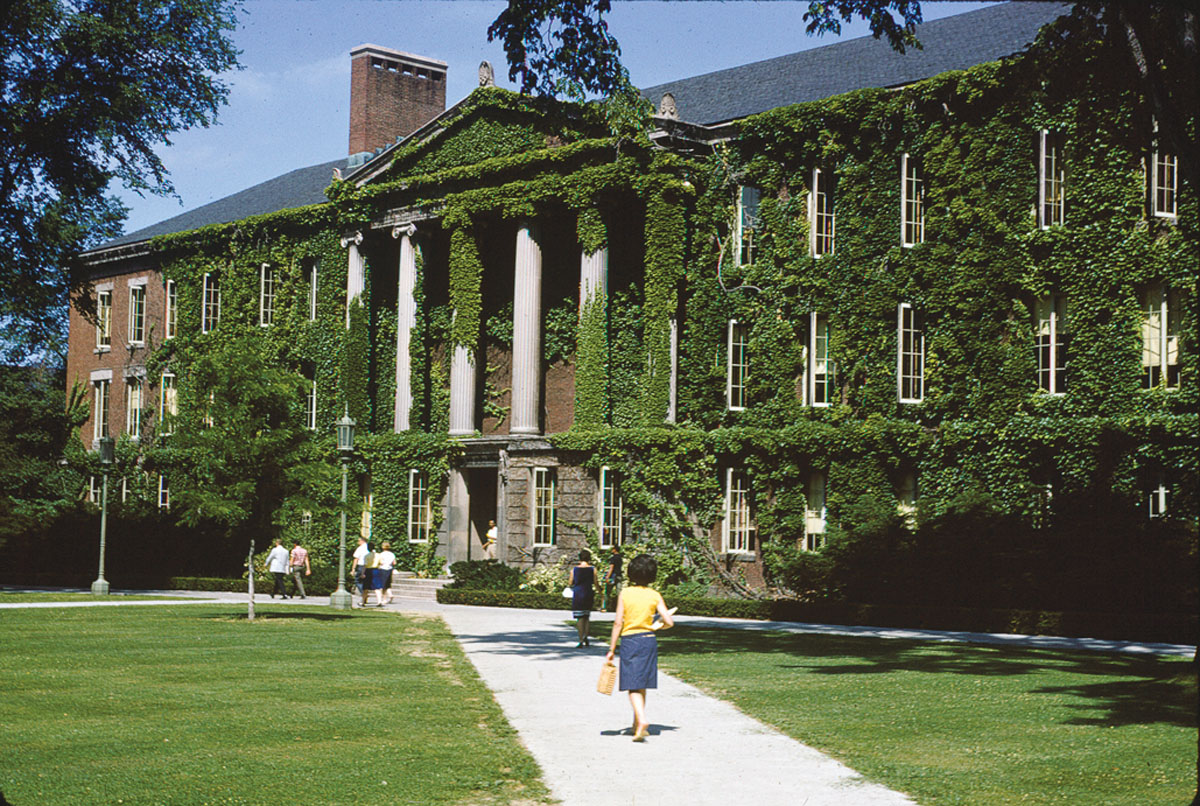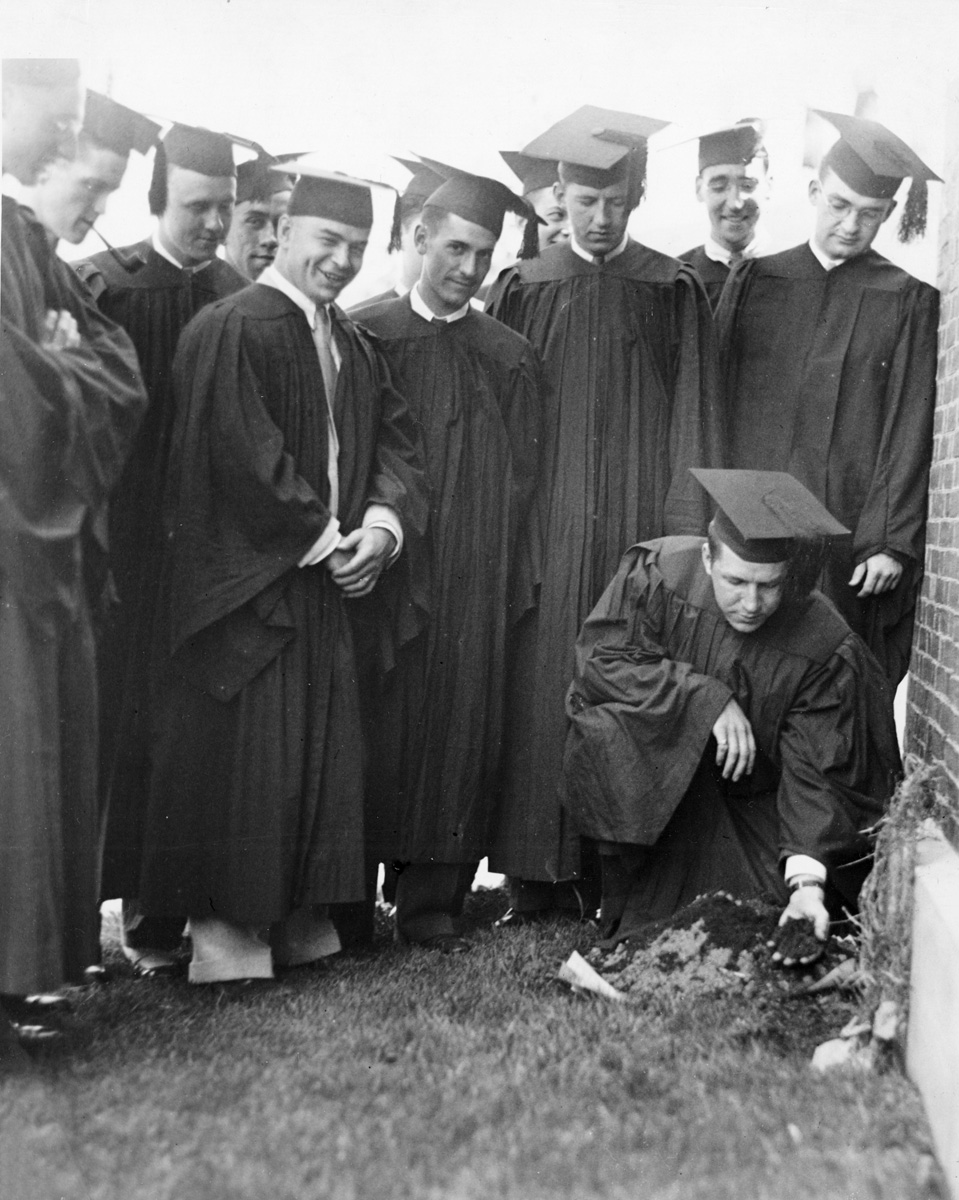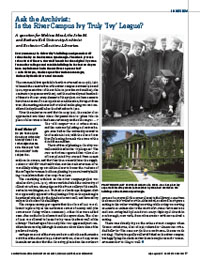In Review
 PLANT SHOOTS; GET LEAVES: Members of a 1930s-era class plant ivy as part of Class Day events (below) that by 1966 had overtaken
the buildings of the Eastman Quadrangle. (Photo: University Libraries/Department of Rare Books, Special Collections, and Preservation)
PLANT SHOOTS; GET LEAVES: Members of a 1930s-era class plant ivy as part of Class Day events (below) that by 1966 had overtaken
the buildings of the Eastman Quadrangle. (Photo: University Libraries/Department of Rare Books, Special Collections, and Preservation) (Photo: University Libraries/Department of Rare Books, Special Collections, and Preservation)
(Photo: University Libraries/Department of Rare Books, Special Collections, and Preservation)Need History?
Do you have a question about University history? Email it to rochrev@rochester.edu. Please put “Ask the Archivist” in the subject line.
Every summer, the University’s buildings and grounds staff trims the ivy on the Eastman Quadrangle. The whole process takes 90 staff hours. Our staff heard that the original ivy came from other colleges and notable buildings in Rochester: do you have any information in the Archives to prove that?
—John McIntyre, trades supervisor and area manager, University Horticulture and Grounds
The ceremonial first spadeful of earth was turned on May 21, 1927, to launch the construction of the River Campus. Between 1926 and 1930, representatives of the architects (Gordon and Kaelber), the contractor (Hopeman Brothers), and the University met hundreds of times to discuss every element of the project. No item seems to have been too small to escape their consideration, but apart from trees, the meeting minutes indicate that landscaping was not considered in depth until after the dedication in 1930.
Thus the minutes record that in May 1931, the senior class approached President Rhees for permission to “plant ivies in place of class trees as has been customary on the old campus. . . .” The “old campus” was at Prince Street, and the custom of planting a class tree began even before the University moved to that location in 1861, with the Class of 1858 literally leaving its mark via a tree with a dated stone marker.
The tradition of planting a class ivy was well established in the “ivy-leagues.” The New York Times reported that Yale’s class of 1886 planted ivy sourced from Mount Helicon in Greece, and that less than a month later the supplication to “Old Eli” was itself stolen. But the Rochester men of ’31 were likely taking up a tradition closer to home: the students of the College for Women had been planting ivy on University buildings to celebrate their Class Day since 1908.
The consulting architect on the River Campus project was Charles Platt (1861–1933), whose work included the University of Illinois at Urbana-Champaign and the Freer Gallery of the Smithsonian in Washington, D.C. Trained as a landscape designer, Platt was apparently opposed to the planting of ivy on the quadrangle: he ordered wisteria for the façade of Gavett Hall, and favored ivy only on the backs of the buildings.
The Campus newspaper reports that the Class of 1931 was allowed to place ivy at the northwest corner of Morey Hall (the corner now facing Wilson Commons). Other ivies were added soon after on the back of Gavett and the Gymnasium. The Class of 1932 was allowed to locate its ivy “near the front wall of the Library.” The heritage of the early ivies was apparently not considered noteworthy, although the minutes show discussion of the preferred variety.
Perhaps one root of the story can be traced to the 35th-reunion activities of the Class of 1899. Robert Pattison, Class of 1899, wrote in Rochester Review that the class’s ivy, planted on the northeast corner of Morey Hall (the corner closest to the library) came from the home of Sir Walter Scott in Abbotsford, Scotland. Scott gave a cutting to the writer Washington Irving while Irving was serving as American ambassador to the Court of St. James between 1842 and 1846. Irving had it planted at St. Mary’s Episcopal Church in Scarborough, New York, from whose rector Pattison received a cutting.
There was already ivy on the Prince Street Campus when Thomas Swinburne, Class of 1892, referred to “alma mater’s vine-clad halls” in “The Genesee” (in the second verse—the one we do not sing). The ivy is equally well established on the River Campus, but happily kept in check so that there is ample room for “sweetest memories” to cling as well.

